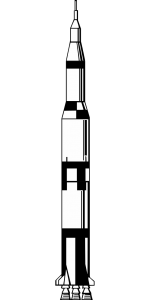At our last San Antonio Bible Based Science Association meeting, while watching President Scott Lane discuss the bombardier beetle, my mind flashed back to the documentary “Moon Machines 1 – Saturn V Rocket.”1 The Saturn V rocket was perhaps the most awesome machine ever built by man. The Soviets had the N-1 Rocket, but it did not prove to be as reliable as the Saturn V.2

The Saturn V was a three stage rocket. Stages of the rocket would drop off as their fuel was expended, lightening the load for the remaining stages. Particularly Stage 2 had to be made lighter to compensate for the rocket’s payload – the command and lunar landing modules.
The fuel for the Saturn V had two components, kerosene and liquid oxygen. These had to be kept separate prior to the burning of the fuel. To save weight, the engineers put the two tanks right next to each other – separated by a single bulkhead. This was a problem because there was a 120° F [67° C] temperature difference between the fuel components. But they were able to do it because, according to George Phelps, Senior Project Engineer, “Engineers can just about do anything.”
Like the Saturn V rocket, the bombardier beetle has two fuel components – hydrogen peroxide and hydroquinone. Darwinists have focused a lot of attention on the fact that these components do not actually explode when brought together.3 But this presents another problem.
Both the Saturn V rocket and the bombardier beetle require an ignition source. The bombardier beetle injects two catalysts into the combustion chamber to produce the explosive reaction. The hydrogen peroxide/hydroquinone fuel mixture must be kept separate from the catalysts until time for use.4
The Saturn V had an igniter similar to a pilot light. During one of the test launches, an igniter actually failed; causing one of the J-2 engines of the second stage to shut down. The team examining the problem determined it was an issue with the fuel line to the igniter and decided to use a different material to for the fuel line.
Here’s the important point
When something was not working correctly on the Saturn V rocket or any other rocket, teams of engineers, scientists and technicians would painstakingly sift through the data, plus the expended rocket or wreckage of the rocket, to determine the cause. Then they would go to work on a solution.
Now imagine these teams of scientists, engineers and technicians using the Darwinian model to design the Saturn V and come up with solutions to the rocket not performing. Imagine them – without trying to figure out what went wrong – just randomly trying different things until the rocket worked. What would have happened? They would never have successfully launched! How many components and systems that were working would they have broken before stumbling upon a fix?
Can you picture this?
Imagine starting out with the instructions to make a bottle rocket and, without putting any thought into it,  randomly changing the instructions. When a change makes the rocket completely fail it gets eliminated. When the rocket does not fail, but there is no improvement or a slight drop in performance, you are stuck with these changes (like genetic load building up from mutations). You continue making additional random changes, hoping for the best.
randomly changing the instructions. When a change makes the rocket completely fail it gets eliminated. When the rocket does not fail, but there is no improvement or a slight drop in performance, you are stuck with these changes (like genetic load building up from mutations). You continue making additional random changes, hoping for the best.
Are you ever going to end up with the instructions to make a Saturn V rocket?
Keep in mind you have no idea what a Saturn V rocket is or where you are going. You are just trying to see if the next bottle rocket worked better than the last one – or maybe just worked better in a particular environment.
This is exactly how the Darwinists are saying the bombardier beetle was developed. Through genetic mutations (random changes in the instructions for making this beetle), natural selection (throwing out changes that did not work) and the magic wand of time everything came into being. The combustion chamber, the glands to make the fuel components including the catalysts, the valve that separates the fuel reservoir from the combustion chamber and opens when needed, the muscles that squeeze the fuel contents into the chamber, the plumbing involved, and the ability to control the expelling of this noxious mixture – all formed and came together using only these tools.
And we have not even talked about how we got a beetle to start with.
It took teams of engineers, scientists, technicians, craftsmen and specialists to not only design but overcome all the problems of building and making the Saturn V rocket function. It was such an enormous undertaking that different companies built different sections of the rocket. Added to this were the logistics of getting all of these components to function as a single rocket.
According to the Darwinists, we cannot even consider that God designed the bombardier beetle. They assert this explanation is not naturalistic so it is not “scientific.”
If this were the definition of “science”, what we observed happen in the making of the Saturn V is not “scientific.”
You may well ask yourself, Who is not being scientific?
“O Lord, what a variety of things you have made! I know that you can do anything, and no one can stop you.” Job 42:2 NLT
Terry Read
- https://www.youtube.com/watch?v=o39UlJlMce8 — Moon Machines 1 – Saturn V Rocket – Stage 2 begins at 14:00.
- https://www.youtube.com/watch?v=U9fkYIrRwbo – N-1 Rocket Launches
- https://ncse.com/cej/2/1/bombardier-beetle-myth-exploded
- https://www.nationalgeographic.com/science/phenomena/2015/04/30/how-this-beetle-creates-500-explosions-per-second-in-its-bum/







